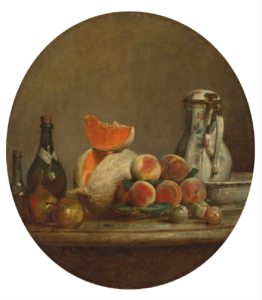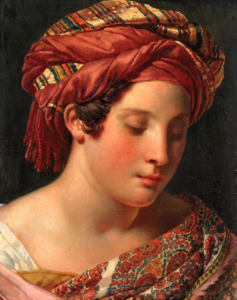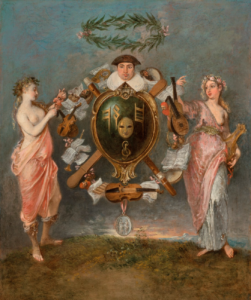
Le melon entamé by Jean Siméon Chardin
Normally, there wouldn’t be much to write about for the Old Masters sale at Christie’s in Paris on Wednesday, June 12th. However, when looking at all the numbers, something might seem a bit confusing. Nearly 40% of the lots went unsold. Yet how did it make almost double the amount of money specialists initially expected?
The Maîtres Anciens sale on Wednesday featured thirty-seven lots, showcasing a wide variety of work, from fifteenth-century religious art to paintings by John Herring Sr. And J.A.D. Ingres. However, it was an eighteenth-century French painting that dominated, and now we see why the sale went so well. Christie’s specialists describe the 1760 still-life Le Melon entamé by Jean Siméon Chardin as a masterpiece of the artist’s late career. Chardin was one of the great French still-life painters of the eighteenth century and influenced later generations of artists like the Impressionists. The painting itself has an impressive provenance, with previous owners including Guillaume-Jean Constantin, the curator of Empress Josephine’s art collection. Since 1876, it has been part of the collection of the French branch of the Rothschild family. The current owners are the descendants of Baron Henri James Nathaniel de Rothschild, who owned the painting from 1899 to 1947. With an estimate range of €8 million to €12 million, Le Melon entamé was set to become one of the most valuable Chardin paintings ever sold at auction. The last time a quality work by Chardin sold at auction was at Artcurial in March 2022, when Le panier des fraises des bois sold for €24.38 million w/p. Had Le Melon entamé sold within its estimate, the sale would have still done well in terms of the amount of money Christie initially predicted and might have been the second most valuable work by the artist sold at auction. However, a bidding war broke out, with several buyers pushing it well past the estimate. The hammer eventually came down at €23 million / $24.9 million (or €26.7 million / $28.9 million w/p), making it the most expensive work by the artist sold at auction.

L’Odalisque by Anne-Louis Girodet-Trioson
The rest of the sale was peanuts compared to the Chardin. However, many of the works that sold still did fairly well. In second place was L’Odalisque by Anne-Louis Girodet-Trioson, a pupil of Jacques-Louis David. Though an odalisque was just the term used for a chambermaid for Ottoman Turkish harems, the word in the West came to refer to the concubines themselves. Paintings of odalisques became rather popular among Orientalist artists in France, but they almost always served as erotic paintings. Nineteenth-century painters like Jean-Auguste-Dominique Ingres, Eugène Delacroix, Jean-Léon Gérôme, and Frederick Arthur Bridgman all abided by this tradition. However, Girodet’s odalisque breaks this standard, opting instead for an intimate portrait of a Turkish chambermaid in a patterned turban. Like the Chardin, L’Odalisque also sold above its estimate, becoming one of the sale’s surprises. Predicted by Christie’s to sell for no more than €120K, L’Odalisque hammered at €300K / $324.8K (or €378K / $409.3K w/p), or two-and-a-half times its presale high estimate.
While L’Odalisque immediately preceded the Chardin, the sale’s third-place lot came immediately after. Jean-Antoine Watteau’s painting L’alliance de la Musique et de la Comédie stands out among the still-lifes and portraits as more allegorical. Meaning The Alliance of Music and Comedy, the painting looks almost like a rendering of a coat of arms, with a central escutcheon and two supporters in the form of females in Greco-Roman-style robes. The figures represent music and comedy as their classical muses, Thalia and Terpsichore. The central shield, surrounded by sheet music and instruments, contains musical notes and a theatrical mask. Everything is topped by a man’s head, likely that of the French stock character Crispin, related to the commedia dell’arte character Scaramouche. While mythological figures and allegories were not new subjects for the time, the themes in the painting are so specific that specialists have deduced that this was a commission from a particular client of Watteau’s. The painting last sold at Sotheby’s Paris in October 2022 for €480K hammer (or €604.8K w/p). This means that, though it was one of the top lots on Wednesday, it took a slight dip in value after selling for just €280K / $303.2K (or €352.8K / $382K w/p).

L’alliance de la Musique et de la Comédie by Jean-Antoine Watteau
There were only a few surprises at Christie’s on Wednesday, one being the Girodet painting. However, the biggest surprise to sell exponentially beyond its high estimate was the sale’s very first lot. Personnages dans une galerie antique by Hubert Robert dates to the artist’s early career in the 1760s. It shows a smattering of figures in vaguely Greco-Roman dress set against a backdrop of classical architecture. The setting does not match any specific place. Rather, Robert created this fictional structure to serve as a ruin around which people live their lives, a subject that the artist would return to frequently. Estimated to sell for no more than €60K, Personnages dans une galerie antique worked its way up to sell for €180K / $194.9K (or €226.8K / $245.6K w/p), or three times the high estimate.
With thirty-seven available lots, Christie’s predicted the entire sale to bring in €14.8 million at most. The final hammer price ended up being €24.89 million / $26.9 million (or €29.1 million / $31.5 million w/p), or about 68% higher than expected. However, one must remember that the Chardin still life comprised 92% of the sale’s total. It would have made up a large percentage of the sale’s total regardless of how much it sold for. Therefore, part of the sales success relied entirely on that one painting. But while Christie’s made a relatively surprising amount of money from this one sale, the other numbers are slightly more disappointing. Of the thirty-seven lots, fourteen did not generate sufficient interest to sell, giving Christie’s a 62% sell-through rate. Only eight lots (22%) sold within their estimates, with an equal number selling above and seven (19%) selling below. Without the Chardin, the sale still would have done well in terms of the money it made, but that is only because of the lots that sold for greatly over their estimates, like the Girodet and the Robert.
Christie’s Paris Old Masters Sale
Le melon entamé by Jean Siméon Chardin
Normally, there wouldn’t be much to write about for the Old Masters sale at Christie’s in Paris on Wednesday, June 12th. However, when looking at all the numbers, something might seem a bit confusing. Nearly 40% of the lots went unsold. Yet how did it make almost double the amount of money specialists initially expected?
The Maîtres Anciens sale on Wednesday featured thirty-seven lots, showcasing a wide variety of work, from fifteenth-century religious art to paintings by John Herring Sr. And J.A.D. Ingres. However, it was an eighteenth-century French painting that dominated, and now we see why the sale went so well. Christie’s specialists describe the 1760 still-life Le Melon entamé by Jean Siméon Chardin as a masterpiece of the artist’s late career. Chardin was one of the great French still-life painters of the eighteenth century and influenced later generations of artists like the Impressionists. The painting itself has an impressive provenance, with previous owners including Guillaume-Jean Constantin, the curator of Empress Josephine’s art collection. Since 1876, it has been part of the collection of the French branch of the Rothschild family. The current owners are the descendants of Baron Henri James Nathaniel de Rothschild, who owned the painting from 1899 to 1947. With an estimate range of €8 million to €12 million, Le Melon entamé was set to become one of the most valuable Chardin paintings ever sold at auction. The last time a quality work by Chardin sold at auction was at Artcurial in March 2022, when Le panier des fraises des bois sold for €24.38 million w/p. Had Le Melon entamé sold within its estimate, the sale would have still done well in terms of the amount of money Christie initially predicted and might have been the second most valuable work by the artist sold at auction. However, a bidding war broke out, with several buyers pushing it well past the estimate. The hammer eventually came down at €23 million / $24.9 million (or €26.7 million / $28.9 million w/p), making it the most expensive work by the artist sold at auction.
L’Odalisque by Anne-Louis Girodet-Trioson
The rest of the sale was peanuts compared to the Chardin. However, many of the works that sold still did fairly well. In second place was L’Odalisque by Anne-Louis Girodet-Trioson, a pupil of Jacques-Louis David. Though an odalisque was just the term used for a chambermaid for Ottoman Turkish harems, the word in the West came to refer to the concubines themselves. Paintings of odalisques became rather popular among Orientalist artists in France, but they almost always served as erotic paintings. Nineteenth-century painters like Jean-Auguste-Dominique Ingres, Eugène Delacroix, Jean-Léon Gérôme, and Frederick Arthur Bridgman all abided by this tradition. However, Girodet’s odalisque breaks this standard, opting instead for an intimate portrait of a Turkish chambermaid in a patterned turban. Like the Chardin, L’Odalisque also sold above its estimate, becoming one of the sale’s surprises. Predicted by Christie’s to sell for no more than €120K, L’Odalisque hammered at €300K / $324.8K (or €378K / $409.3K w/p), or two-and-a-half times its presale high estimate.
While L’Odalisque immediately preceded the Chardin, the sale’s third-place lot came immediately after. Jean-Antoine Watteau’s painting L’alliance de la Musique et de la Comédie stands out among the still-lifes and portraits as more allegorical. Meaning The Alliance of Music and Comedy, the painting looks almost like a rendering of a coat of arms, with a central escutcheon and two supporters in the form of females in Greco-Roman-style robes. The figures represent music and comedy as their classical muses, Thalia and Terpsichore. The central shield, surrounded by sheet music and instruments, contains musical notes and a theatrical mask. Everything is topped by a man’s head, likely that of the French stock character Crispin, related to the commedia dell’arte character Scaramouche. While mythological figures and allegories were not new subjects for the time, the themes in the painting are so specific that specialists have deduced that this was a commission from a particular client of Watteau’s. The painting last sold at Sotheby’s Paris in October 2022 for €480K hammer (or €604.8K w/p). This means that, though it was one of the top lots on Wednesday, it took a slight dip in value after selling for just €280K / $303.2K (or €352.8K / $382K w/p).
L’alliance de la Musique et de la Comédie by Jean-Antoine Watteau
There were only a few surprises at Christie’s on Wednesday, one being the Girodet painting. However, the biggest surprise to sell exponentially beyond its high estimate was the sale’s very first lot. Personnages dans une galerie antique by Hubert Robert dates to the artist’s early career in the 1760s. It shows a smattering of figures in vaguely Greco-Roman dress set against a backdrop of classical architecture. The setting does not match any specific place. Rather, Robert created this fictional structure to serve as a ruin around which people live their lives, a subject that the artist would return to frequently. Estimated to sell for no more than €60K, Personnages dans une galerie antique worked its way up to sell for €180K / $194.9K (or €226.8K / $245.6K w/p), or three times the high estimate.
With thirty-seven available lots, Christie’s predicted the entire sale to bring in €14.8 million at most. The final hammer price ended up being €24.89 million / $26.9 million (or €29.1 million / $31.5 million w/p), or about 68% higher than expected. However, one must remember that the Chardin still life comprised 92% of the sale’s total. It would have made up a large percentage of the sale’s total regardless of how much it sold for. Therefore, part of the sales success relied entirely on that one painting. But while Christie’s made a relatively surprising amount of money from this one sale, the other numbers are slightly more disappointing. Of the thirty-seven lots, fourteen did not generate sufficient interest to sell, giving Christie’s a 62% sell-through rate. Only eight lots (22%) sold within their estimates, with an equal number selling above and seven (19%) selling below. Without the Chardin, the sale still would have done well in terms of the money it made, but that is only because of the lots that sold for greatly over their estimates, like the Girodet and the Robert.